This post contains affiliate links.
Could a card game make Biology, ecology, anatomy, zoology & botany seem less complex (is it only me who finds biology complex?) and make them even fun? I tried to investigate and show you what’s out there.
And I found 26 biology card games covering several topics, including zoology, virology, human anatomy, and ecology. There is a lot of variety in the game mechanisms that are proposed, with:
- Quiz-based games (especially the “Professor Noggin’s” games)
- Strategy games such as :
- Bidding games (Virulence)
- Draft and tableau games (Peptide, Gene Pool, Ecosystem, Ecologies)
- Fluxx (Nature Fluxx , Anatomy Fluxx) with its rules that change during the play
- Matching games (Digestion, Body Snap)
- What in the Wild, with its 5 different rules
Biology Card Games Comparison Table
| Game | Area | Rule | Age | Price | Players | Rating |
|---|---|---|---|---|---|---|
| Virulence | Virology | Bidding | 11+ | $$$ | 2-5 | ★★★★☆ |
| Peptide: A Protein Building Game | Proteins | Drafting | 14+ | $$$ | 2-6 | ★★★★★ |
| Gene Pool | Genetics | Tableau | 12+ | $$ | 2-4 | ★★★★☆ |
| Ecosystem | Ecology | Tableau | 14+ | $$ | 2-6 | ★★★★★ |
| Nature Fluxx | Ecology | Fluxx | 8+ | $$ | 2-6 | ★★★★★ |
| Ecologies | Ecology | Tableau | 12+ | $$$ | 1-6 | ★★★★★ |
| What in the Wild | Ecology | 5 rules | 8+ | $$$ | 2-7 | ★★★★☆ |
| Anatomy Fluxx | Anatomy | Fluxx | 11+ | $$ | 2-6 | ★★★★☆ |
| The Human Body | Anatomy | Quiz | 11+ | $$ | 2-8 | ★★★☆☆ |
| Digestion – Brain Links | Anatomy | Matching | 11+ | $$ | 2+ | ★★★☆☆ |
| Body Snap | Anatomy | Matching | 10+ | $$ | 1+ | ★★★☆☆ |
| Ocean Animal Card Games | Zoology | Quiz | 8+ | $$$ | 1+ | ★★★★☆ |
| Guess in 10: Animal Planet | Zoology | Quiz | 8+ | $$ | 2-6 | ★★★☆☆ |
| Guess in 10: Underwater Animals | Zoology | Quiz | 8+ | $$$ | 2-6 | ★★★☆☆ |
| What Bird Am I? | Zoology | Quiz | 14+ | $$$ | 2+ | ★★★☆☆ |
| World of Animals | Zoology | Quiz | 8+ | $$$ | 2+ | ★★★★★ |
| Bugs | Zoology | Quiz | 7+ | $$ | 2-6 | ★★★☆☆ |
| Reptiles and Amphibians | Zoology | Quiz | 8+ | $$ | 2-8 | ★★★★☆ |
| World of Dinosaurs | Zoology | Quiz | 8+ | $$ | 2-8 | ★★★★☆ |
| Birds of North America | Zoology | Quiz | 8+ | $$ | 2-8 | ★★★☆☆ |
| Insects and Spiders | Zoology | Quiz | 8+ | $$ | 2-8 | ★★★☆☆ |
| Life in the Ocean | Zoology | Quiz | 8+ | $$ | 2-8 | ★★★★☆ |
| Wildlife Safari | Zoology | Quiz | 8+ | $$ | 2-8 | ★★★★☆ |
| Wildlife of North America | Zoology, Botany | Quiz | 8+ | $$ | 2-8 | ★★★★☆ |
| Wacky Cards Life Science Edition | General Biology | Quiz | 8+ | $$$ | 2-8 | ★★★☆☆ |
| Nerd Words: Science! | General Biology | Quiz | 14+ | $$$ | 2-12 | ★★★★☆ |
Virology Card Game
Virulence (Genius Games)
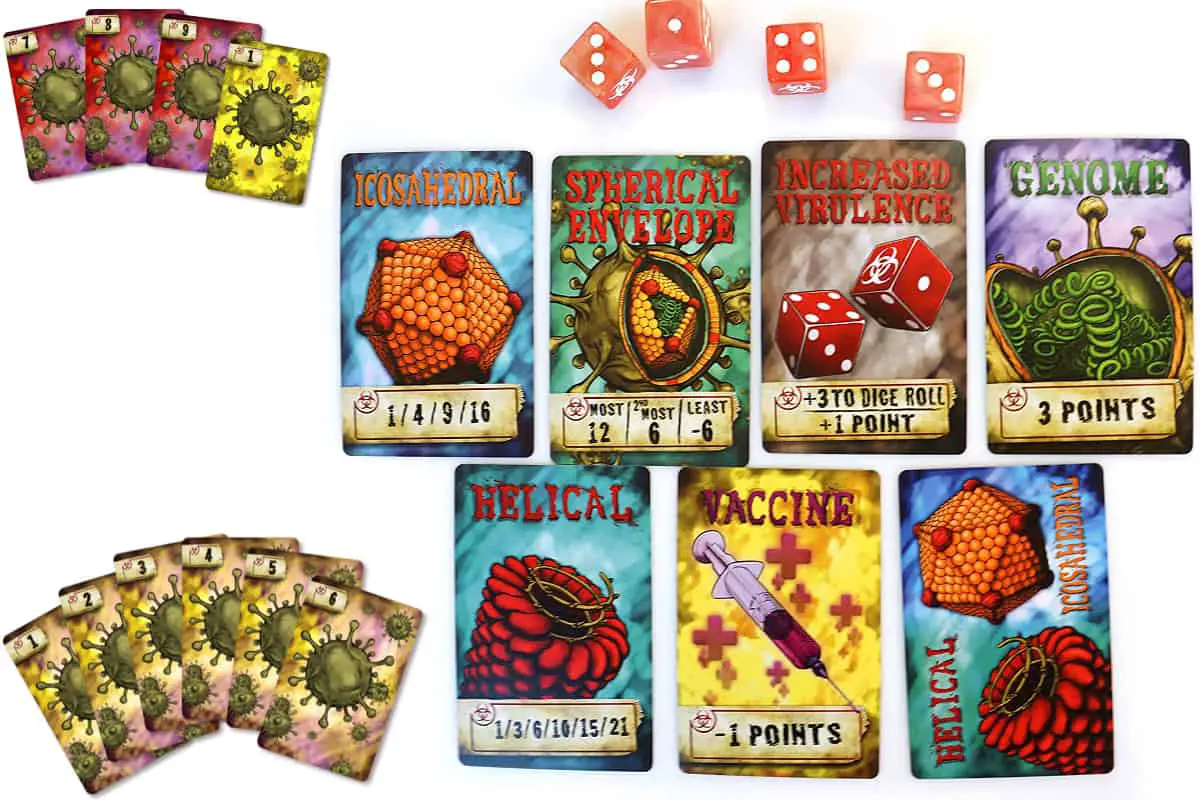
★★★★☆
For Families and Schools | Age 11+ | 2-5 players | Price $20-$30 | Duration 15-20 min | Author: John J. Coveyou
In Virulence , players act as viruses. They collect viral component cards to try to make their virus stronger, and try to avoid vaccines cards. Virulence comprises:
, players act as viruses. They collect viral component cards to try to make their virus stronger, and try to avoid vaccines cards. Virulence comprises:
- 36 bidding cards
- 81 viral component cards (isocahedral, sherical envelope, genome, increased virulence and helical cards)
- 4 bonus scoring cards
- 4 custom virus dice
Players put a secret bid in each turn. The person with the highest bid picks the highest card from the row of available cards. To play the game:
- Players get six bidding cards, numbered 1 to 6.
- Three or five cards (depending on the number of players) are taken from the deck during each round.
- An additional card is drawn and put on the first card in the row if it has a positive number or the second card if it has a negative one.
- Players then place their bids face-down, and flip them at the same time.
- The player with the highest bid picks a card from the set first, then the others follow depending on their bid. The player with the lowest bid gets the negative card if there is one.
Virulence:
- Features accurate science vocabulary – especially the names of virus structures and components
- Is easy and quick to play, so you can use it in classrooms.
While it is fun to play, it does not really teach students about how viruses work. It only focuses on the names. Children who are starting to learn about viruses will not gain new knowledge from the cards. To make the game more educational, you should research the terms first and help younger players what each term means.
Molecular Biology Card Game
Peptide: a protein building game (Genius Games)
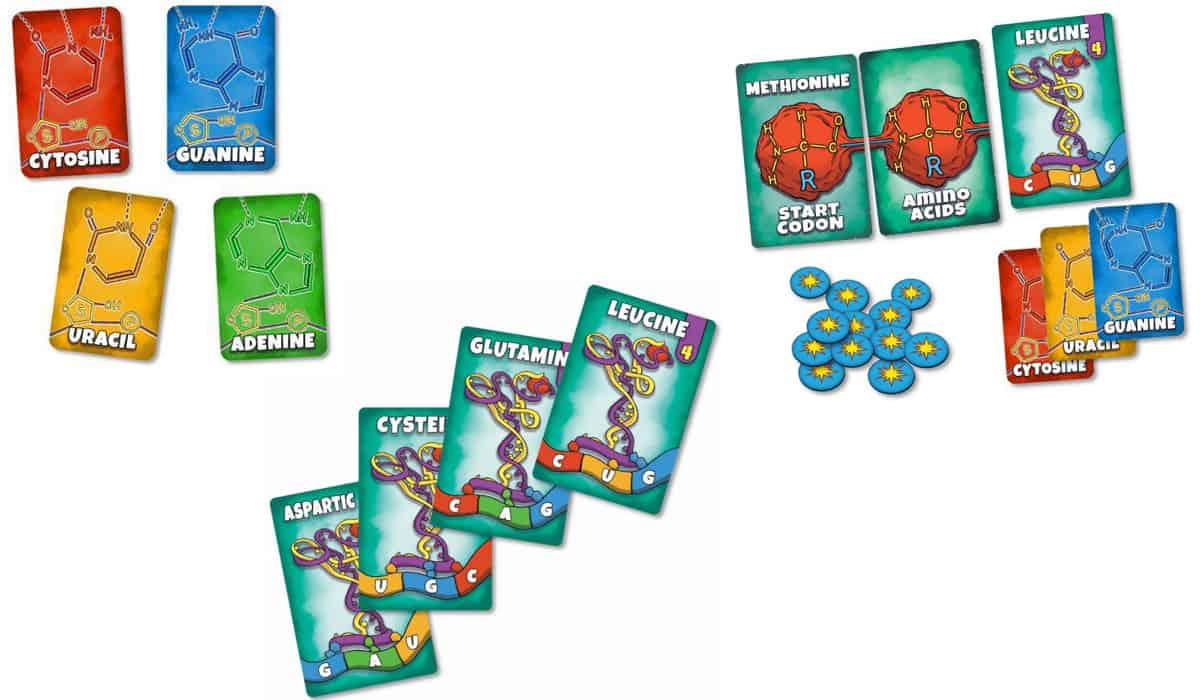
★★★★★
For Families | Age 14+ | 2-6 players | Price $20-$30 | Duration 30-45 min | Author: John J. Coveyou
Peptide is a drafting card game where players aim to create the best protein (polypeptide chain). It comprises :
is a drafting card game where players aim to create the best protein (polypeptide chain). It comprises :
- Organelles (ribosome, nucleus, mitochondria, enzymes..), amino acids (methionine…), and mRNA cards
- 9 players cards
- 32 ATP energy tokens.
This game shows how amino acids connect to form proteins. There are two phases during the gameplay:
- Organelle selection – players take turns selecting organelle cards
- Organelle resolution – players exchange their organelle cards for resources (ATP tokens or RNA cards) or use their ATPs to buy an amino acid card.
- they use their ATP tokens and other resources to link amino-acids to make the longest protein possible
Reference cards help check what to do with organelles. The player with the best protein (polypeptide chain) wins the game. I like Peptide because:
- It is a simple and fun way to explain protein synthesis
- It is scientifically accurate
Playing Peptide takes at least 30 minutes, making it more advisable at home than for the classroom.
Genetics Card Game
Gene Pool (TheGameCrafter)
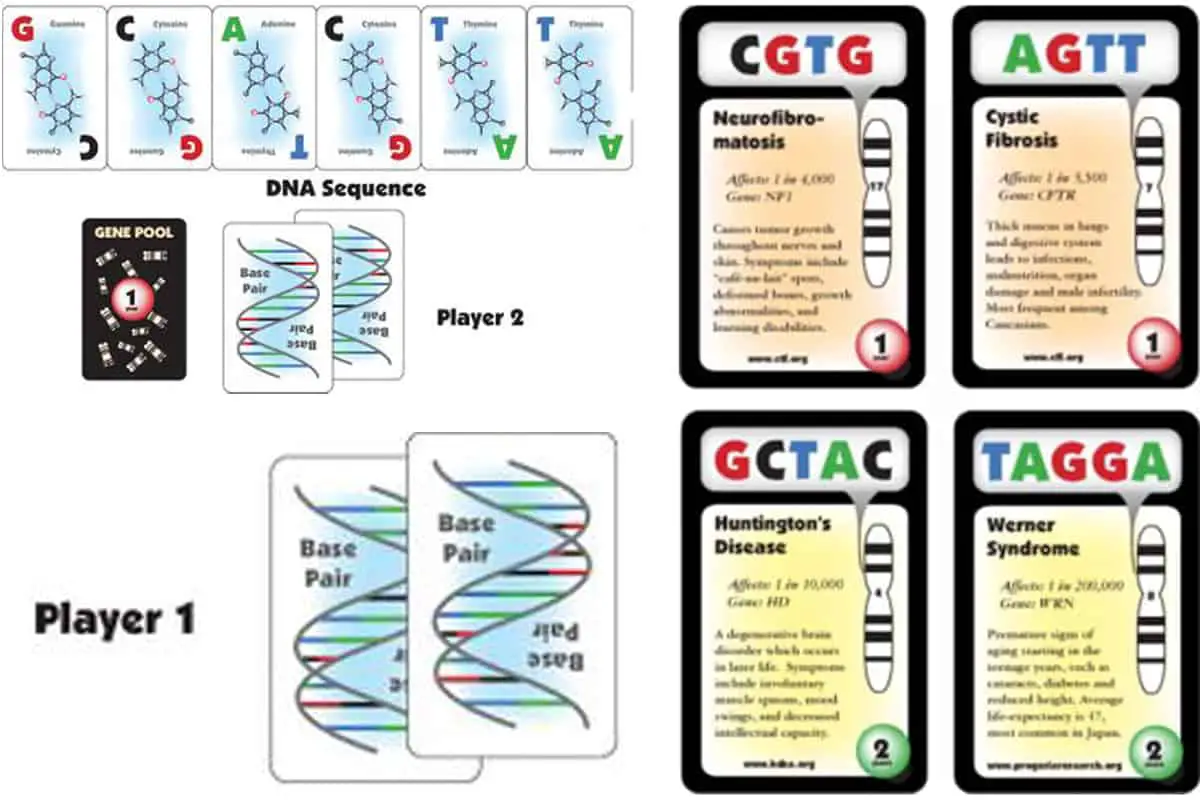
★★★★☆
For Families and Schools | Age 12+ | 2-4 players | Price $10-$20 | Duration 20-30 min | Author: Mark Goadrich
Gene Pool is a tableau-building card game that teaches students how the evolution of organisms starts from genes and cells. Players race against one another to evolve three organisms.
is a tableau-building card game that teaches students how the evolution of organisms starts from genes and cells. Players race against one another to evolve three organisms.
The premise of the game is that the world has just begun. Each player evolves their first living organisms. Each set has seven organism cards and 74 gene pool cards that include:
- Genes
- Cells – you need enough genes to play these, and you need several cell cards to get an organism card
- Viruses – can be used against an opponent’s cell or for clearing mutations
- Mutations – immediately played once drawn and would affect the entire game unless removed
Gene Pool is easy to play and set up. I also like that:
- The gene research cards feature information about diseases related to genetics, such as Hemophilia Type A, Cystic Fibrosis, Sickle Cell Anemia, Muscular Dystrophy, Huntington’s Disease, etc…
- It also includes reference cards
This game help to introduce genetics in middle school and high school. In addition, it is quick to play, so it can be used in homes and schools.
Ecology Card Games
Ecosystem (Genius Games)
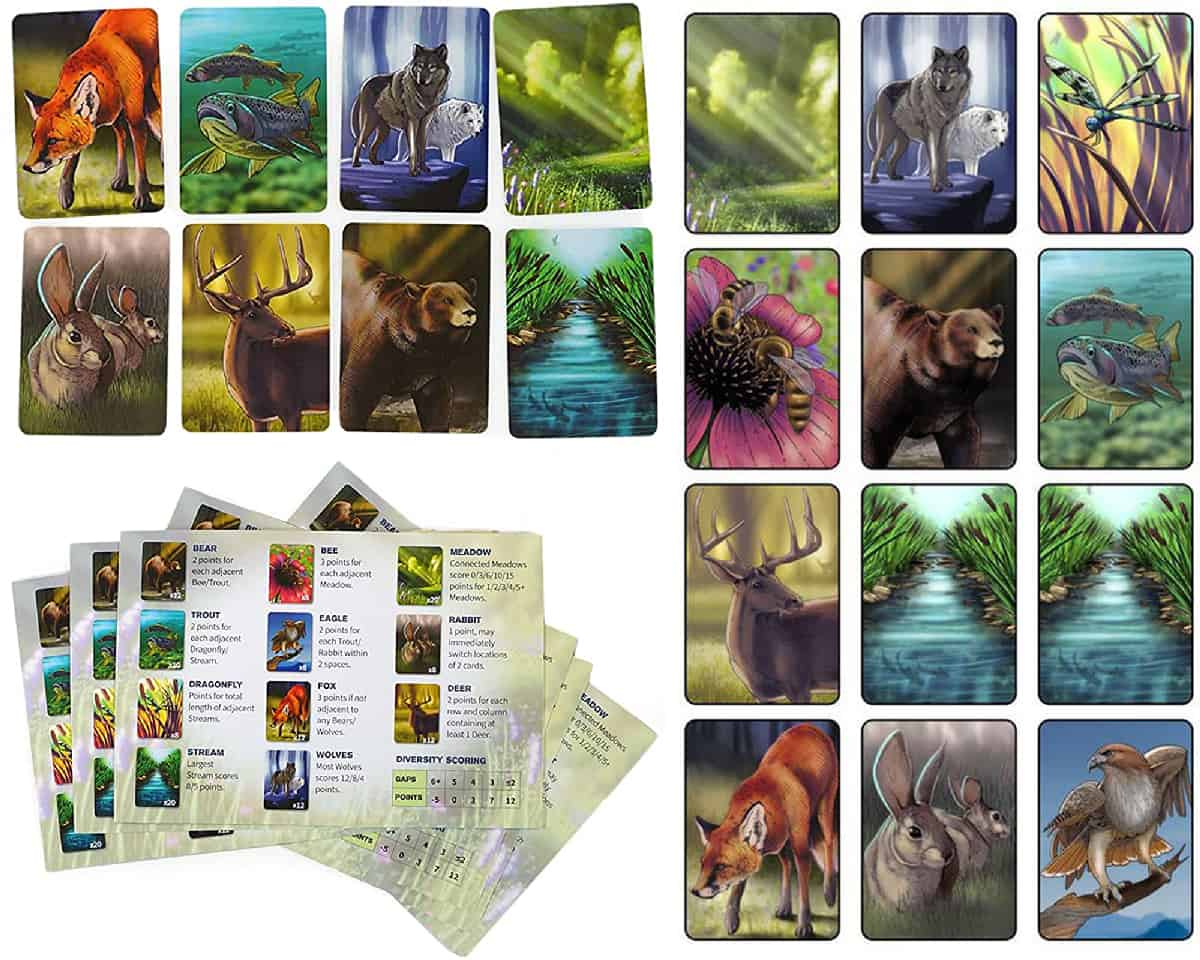
★★★★★
For Families | Age 14+ | 2-6 players | Price $10-$20 | Duration 15-20 min | Author: Matt Simpson
Genius Games’ Ecosystem is a card drafting and tableau-building game featuring beautifully designed cards representing different organisms and habitats. The game’s goal is to create biodiversity, and the player with the most points wins the game.
is a card drafting and tableau-building game featuring beautifully designed cards representing different organisms and habitats. The game’s goal is to create biodiversity, and the player with the most points wins the game.
Each player takes turns in picking which flora, fauna, and environments they will include in their ecosystem. Ecosystem is easy and quick to play because there is no waiting time. Everyone picks a card simultaneously and passes the other cards to the player next to them. The game is done when there are no cards left.
Players earn points when they make a perfect alignment between the animals and the environments that they will most thrive in. They earn or lose points depending on their choices. If they have a:
- tableau with monocultures – or no biodiversity – they receive a penalty
- tableau with biodiversity: they receive additional points
I like this game because it explains the importance of biodiversity in an ecosystem in its scoring system. So, your children will learn that an environment will not thrive if only one dominant species exists.
Nature Fluxx (Looney Labs)
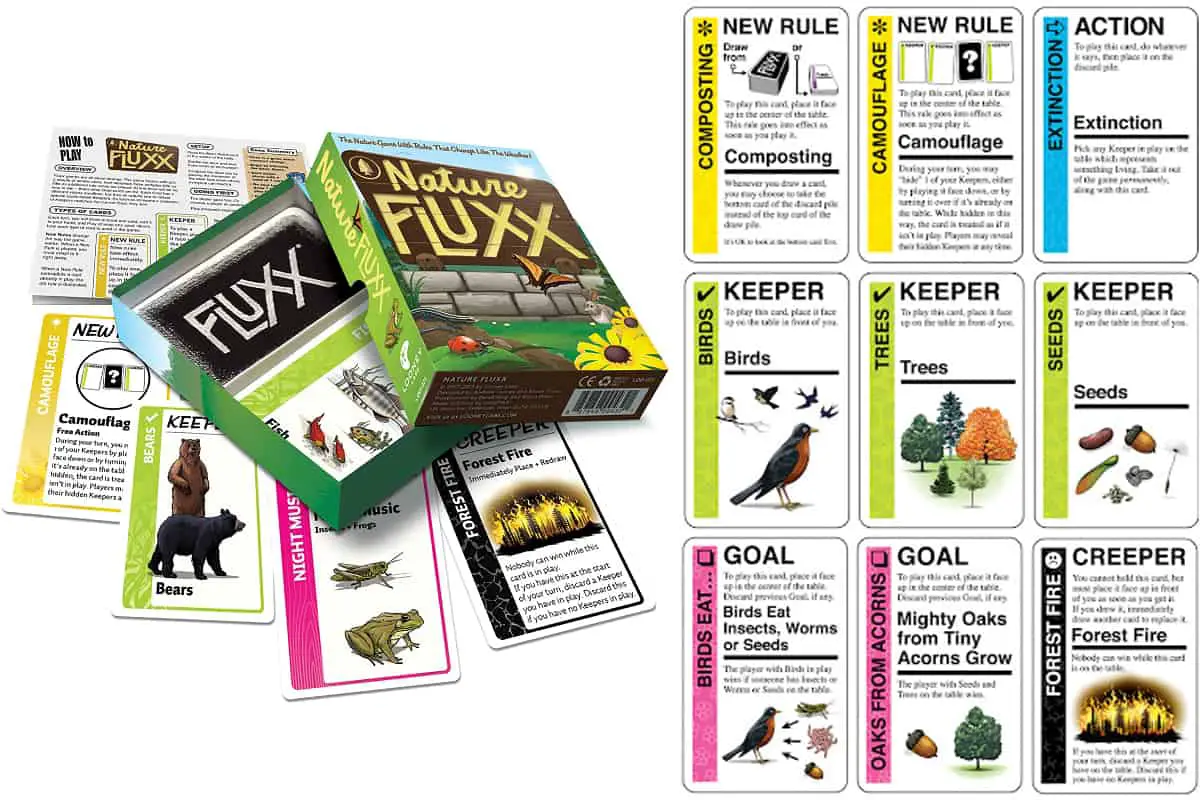
★★★★★
For Families and Schools | Age 8+ | 2-6 players | Price $10-$20 | Duration 10-30 min
The principle of all Fluxx games is that rules change during the game according to the “Rule” and “Goal” cards that players play along the game.
If you’re familiar and you like the Fluxx games, then Nature Fluxx is right up your alley. This version features an environmental theme that shows its players how the environment works.
is right up your alley. This version features an environmental theme that shows its players how the environment works.
It has 100 cards in four types:
- New Rule – changes the way the game works and must be instantly played when drawn
- Keeper – cards that help you win a goal and are placed face up in front of you
- Goal – placed in the center of the table and tells what keeper you need to win
- Action – single-play cards with instructions like, “discard all keeper cards on the table”
- Creeper – cards that prevent players from winning the game and features real environmental disasters like forest fires, drought, and forest fires
While the rules may change at every turn, the game is still easy to play because you only need to follow what the last card says. And the player who completes a goal first wins the game. Nature Fluxx is great educationally because:
- The goal cards show real interactions between species (animals and plants)
- It includes creeper cards featuring real natural disasters that impede the growth of fauna and flora
However, I hope they would also include a description of the events and creeper cards, and explain how these events affect ecosystems, so younger players will learn more information about the environment while playing.
Ecologies (TheGameCrafter)
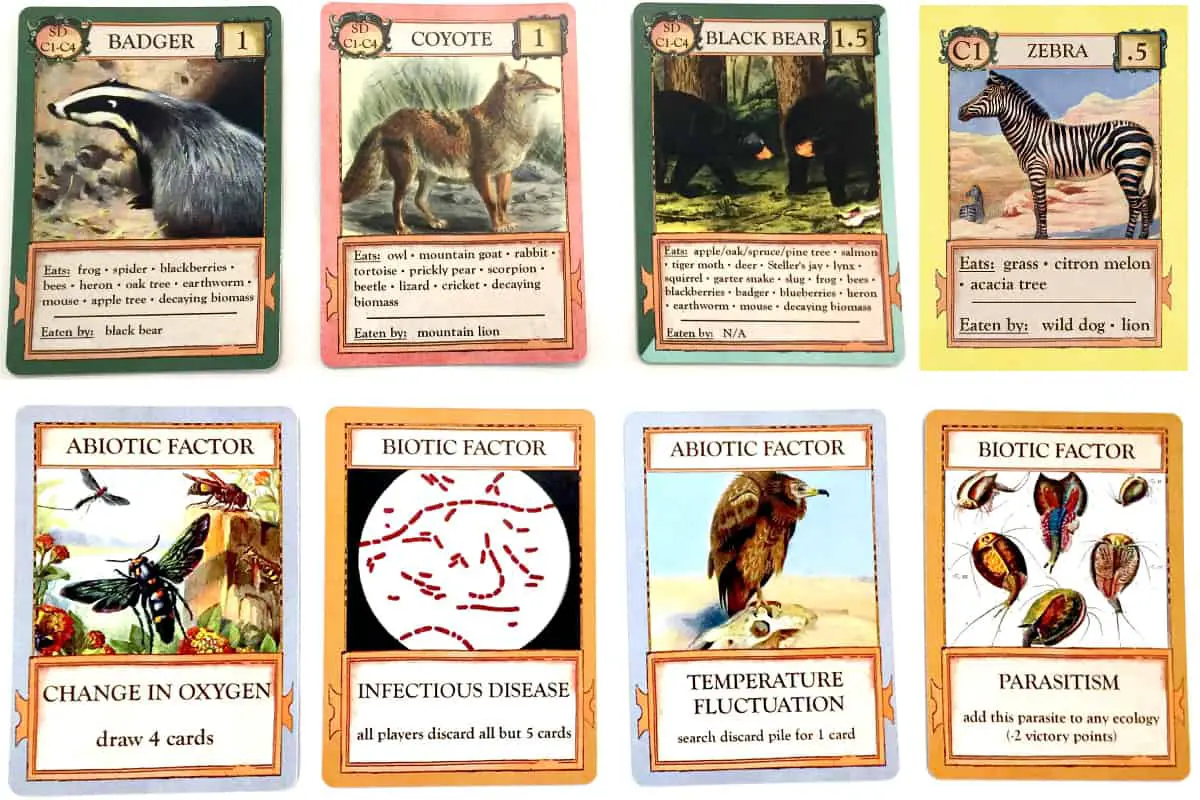
★★★★★
For Families | Age 12+ | 1-6 players | Price $30-$40 | Duration 30-40 min
Ecologies is a drafting and tableau-building card game designed by a biology instructor. It aims to teach players how to build and maintain diverse biomes.
is a drafting and tableau-building card game designed by a biology instructor. It aims to teach players how to build and maintain diverse biomes.
Each set comes with 108 cards featuring vintage Victorian art. These are comprised of:
- 77 color-coded organism cards with varying trophic levels – producer, consumer, scavenger/decomposer/detritivore
- 7 biomes – desert, grassland, tundra, marine, temperate forest, coniferous forest, and tropical forest, with brief descriptions
- 24 abiotic and biotic factor cards that negatively affect your opponents or give perks or bonuses to you
There are four steps to this game, and only the first one is mandatory for all players for each round.
- Draw 2 cards
- Trade cards with other players
- Play 2 cards to create food chains, food webs, or new ecologies
- Purchase new cards using the cards on hand or the cards on the table
This game accurately shows how ecosystems work. Players cannot build their “ecology” unless they have a biome card, where plants and animals live. Then, they need to play a producer card to support a consumer card. Consumers also have levels (primary, secondary, tertiary, and quaternary) and can only be used in that order. On the other hand, scavengers and decomposers can be used depending on what food they need to thrive.
The biome cards also have bonus perks that can only be used when the player has a healthy “ecology,” composed of five organism cards that play different roles. I like this game because of its scientific accuracy and simplicity. It complements a lesson on ecosystems while still making the game light and fun. You can also expand your deck with the Ecologies: Bizarre Biomes – the sequel to this fantastic card game!
– the sequel to this fantastic card game!
The only thing that I don’t like is the scoring system. It can be challenging to keep tabs on your and your opponent’s score.
What in the Wild (TheGameCrafter)
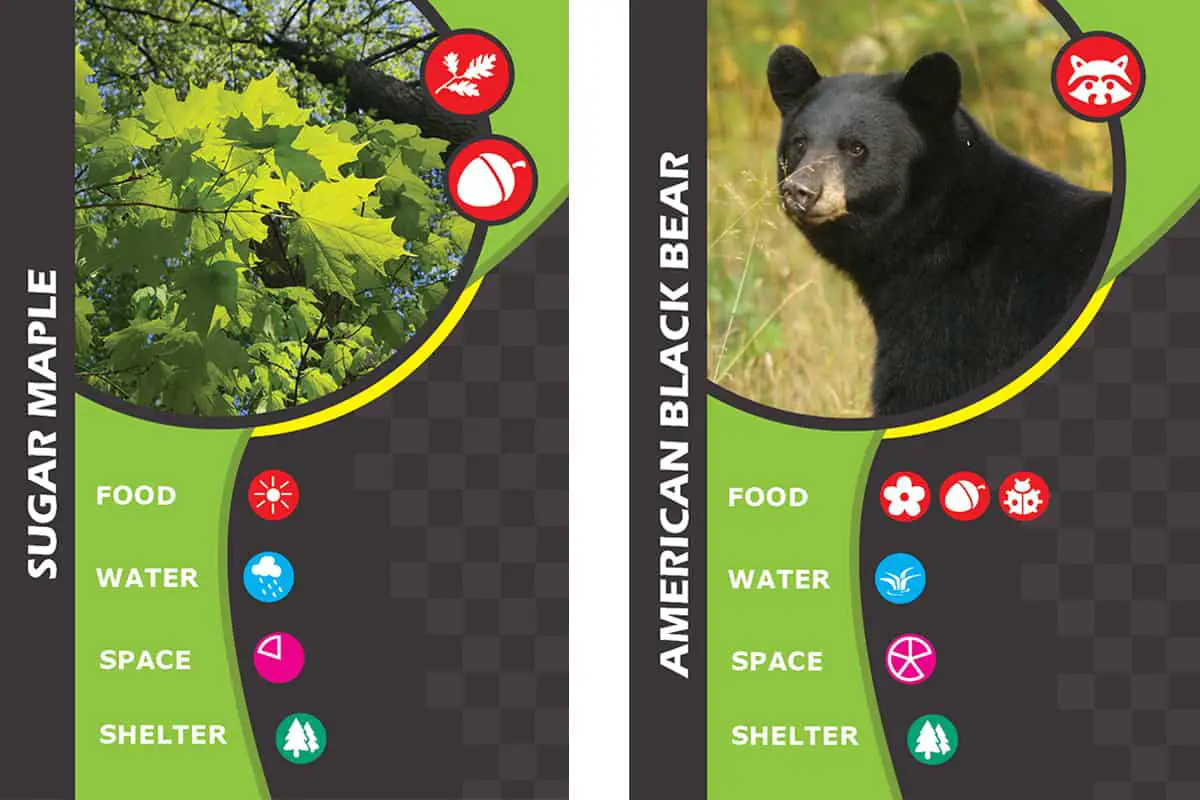
★★★★☆
For Families | Age 8+ | 2-7 players | Price $20-$30 | Duration 5-40 min
What in the Wild features a deck of 120 cards with plants and animal species, food, water, habitats, and the environment they thrive in. The best thing is that you have five different rules with varying levels of difficulty and complexity:
features a deck of 120 cards with plants and animal species, food, water, habitats, and the environment they thrive in. The best thing is that you have five different rules with varying levels of difficulty and complexity:
- Match It! – A memory game where players have to match an organism to its habitat.
- Connect It! – A cooperative tableau-building game where all players race against time to build a resilient ecosystem.
- Slap It! – Players race against each other to claim a card and put as many species in a habitat as they can.
- Group it! – Players try to complete as many sets of 3 cards as possible before the deck runs out.
- Build It! – Players race to build a habitat for their species.
The cards feature actual photos of animals, plants, and their habitats. You can also use them to play scavenger hunts with younger children.
I like this deck because:
- It is for both cooperative and competitive play
- It comes with a booklet that gives more information about the animals and plants featured in the game
The minimalist design with icons representing the resources needed by plants and animals can facilitate playing with younger children (before they can read), although “What in the Wild” is intended for children aged 8 and up.
Although it is more for families, it can be used in classrooms during downtimes and lesson introductions. But, you can also get the What in the Wild – Classroom Pack to get more decks for your students.
to get more decks for your students.
Human Anatomy Card Games
Anatomy Fluxx (Looney Labs)
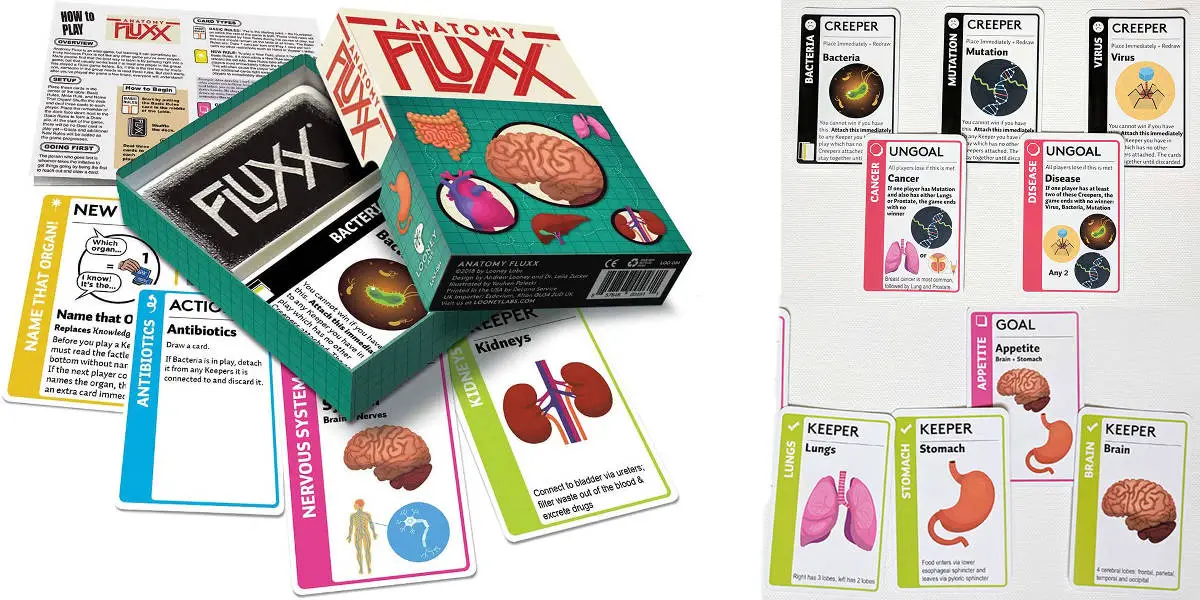
★★★★☆
For Families | Age 11+ | 2-6 players | Price $10-$20 | Duration 30-45 min
Like other Fluxx card games, Anatomy Fluxx is an ever-changing rule game featuring the body’s different organs.
is an ever-changing rule game featuring the body’s different organs.
This version comes with the usual set of cards: New Rule, Goal, Keeper, Action, and Creeper, but with the addition of the Ungoal card: If it is played and the current game setup meets its conditions, all players lose.
What like in “Anatomy Fluxx”:
- It is easy and fun to play with its ever-changing rules
- The keeper cards featuring the organs also include bite-size information about them
- The inclusion of the ungoal cards make it more challenging and exciting to play
- There are three unique rule cards that test the player’s knowledge of human anatomy – “name that organ,” “knowledge bonus,” and “alternate factlets”
The unique rule cards may fall on any organ, so playing this game with students who have already gone through all the body systems is advisable. Otherwise, you can remove these cards so there will be fair gameplay even with younger players.
The Human Body (Outset Media – Professor Noggin’s)

★★★☆☆
For Families | Age 11+ | 2-8 players | Price $10-$20 | Duration 10-20 min
Professor Noggin’s The Human Body is a quiz card game with two difficulty levels – student and scholar, for varied gameplay. Each set comes with a custom die and thirty card games with three question types: trivia, true or false, and multiple choice.
is a quiz card game with two difficulty levels – student and scholar, for varied gameplay. Each set comes with a custom die and thirty card games with three question types: trivia, true or false, and multiple choice.
Each card focuses on a specific topic:
- Bad Breath and Body Odor
- Blood
- Body Facts (3 Cards)
- Body Function
- Body Wastes
- Bones (2 Cards)
- Brain and Nervous System
- Circulatory System
- Digestive System (2 Cards)
- Ears
- Eyes and Sight
- Feats and Records
- Genetics
- Germs
- Hair
- Heart
- History and the Human Body
- Immune System
- Muscles
- Nutrition
- Organs
- Respiratory System
- Skin
- Smell and Taste
- Snot
- Teeth
It covers a lot of anatomy topics, but some body systems are missing. However, I like this game because the answers are with the cards, so your child can receive instant feedback.
Brain Links – Digestion (The Green Board Game)

★★★☆☆
For Families and Schools | Age 11+ | 2+ players | Price $10-$20 | Duration 10-20 min
Digestion – Brain Links is a matching card game that takes players on a food journey in the digestive system. Each box comes with 52 colored-playing cards featuring a mix of real and illustrated parts and 3 rule cards.
The game is easy to play. You only have to take turns in linking the cards in your hand with those already on the table. If your cards do not match anything, then you have to draw a card. The first player to put down all their cards wins.
I like that:
- It is an enjoyable and interactive way of showing how food travels in the body
- It includes trivia about the different parts of the digestive system
- Players can quickly receive feedback as the cards have arrows that show what other cards you can connect with them.
The principle of the rule is too straightforward to make the game fun though.
You have to note with this set is that some parts are spelled in British English. An example is oesophagus which is esophagus in American English.
Body Snap (The Green Board Game)

★★★☆☆
For Families | Age 10+ | 1+ players | Price $10-$20 | Duration 10-20 min
Body Snap is a matching card game that introduces players to the different parts of the body. Each set comes with 52 playing cards, 3 rules cards, and a self-checking guide.
is a matching card game that introduces players to the different parts of the body. Each set comes with 52 playing cards, 3 rules cards, and a self-checking guide.
This card game can be played in two different ways:
- Matching game: players have to match the body part’s name to the illustration or its role or location.
- Snap: players have to link the name, picture of the body part, and its location or its role (shown with an equivalent everyday object like a pump for the heart)
This game teaches to recognize organs and their role in the body – in an analogical way. It can also be played by younger players aged 7 and up with minimal guidance for reading the words.
Players who can read may also play independently because they can quickly check the guide for self-correction.
Zoology Card Games
Ocean Animal Card Games (The Young Scientists Club)
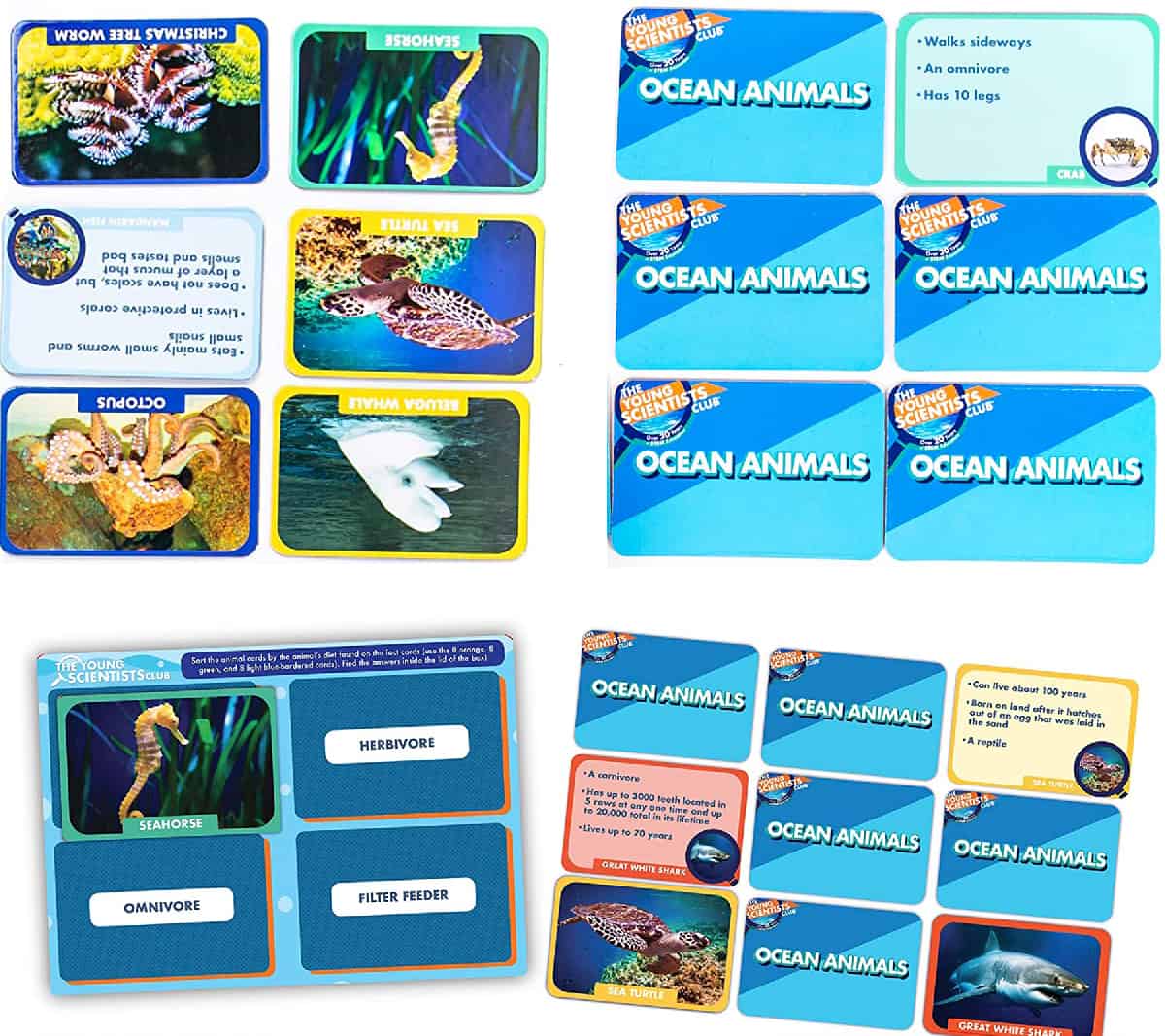
★★★★☆
For Families and Schools | Age 8+ | 1+ players | Price $10-$30 | Duration 10-20 min
Ocean Animals Card Games comes with 80 colored game cards and four rules:
comes with 80 colored game cards and four rules:
- Bingo
- Trivia
- Concentration
- Guess the Animal
Each set comes with 40 animal cards and 40 trivia cards. It also comes with an ocean poster and instructions. I like that:
- There are four different ways to play it, making it more replayable
- Illustrations show actual pictures of ocean animals
- The trivia is presented in bullets for easy reading and remembering of information
- It comes with a poster for playing eye spy with younger children
- The trivia game lets children analyze the animals based on how they eat (carnivores, herbivores, omnivores, and filter feeder)
If you like this set, The Young Scientist Club also has a Prehistoric Animals version.
Guess in 10: Animal Planet (Skillmatics)
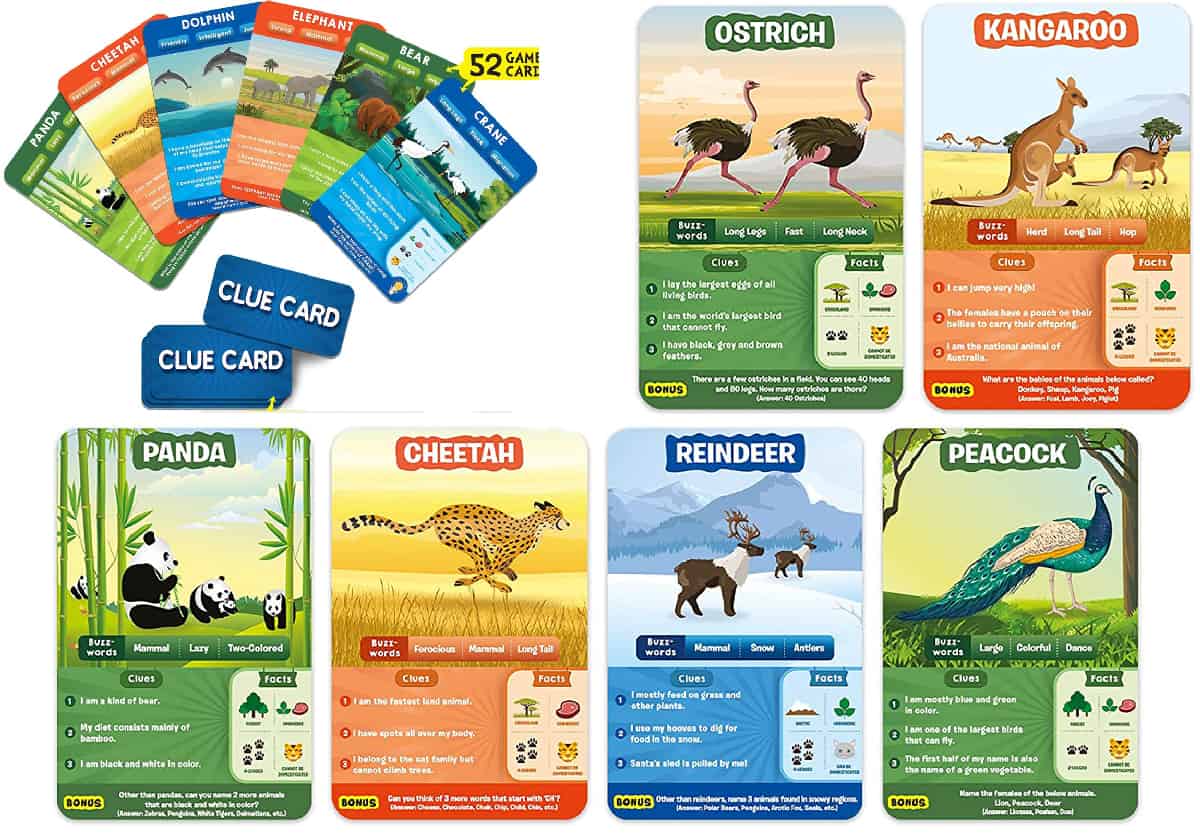
★★★☆☆
For Families | Age 8+ | 2-6 players | Price $10-$20 | Duration 10-20 min
Skillmatics’ Guess in 10: Animal Planet is a quiz card game that teaches your children general knowledge about different animals. Each set comes with 50 game cards and 6 trivia cards.
is a quiz card game that teaches your children general knowledge about different animals. Each set comes with 50 game cards and 6 trivia cards.
Guess in 10 is easy to play. However, it requires that the players read. To play:
- During your turn, you will read the first two buzz words to your opponent
- Then, they can ask you up to ten yes or no questions to help them guess the animal
- If they use the clue card, you will read them a clue from the card.
- Your opponent only gets two chances to guess; otherwise, they lose the card.
- If they answer correctly, they can also answer the bonus question, earning them the third buzzword in their next turn.
The first player with seven cards wins.
I like that it develops critical thinking. Children also learn more information about each animal with the added fun facts in each card. There is also a version with no reading required for younger players – Guess in 10 Junior: Animal Kingdom .
.
My only problem is that there are only 50 playing cards.
Guess in 10: Underwater Animals (Skillmatics)
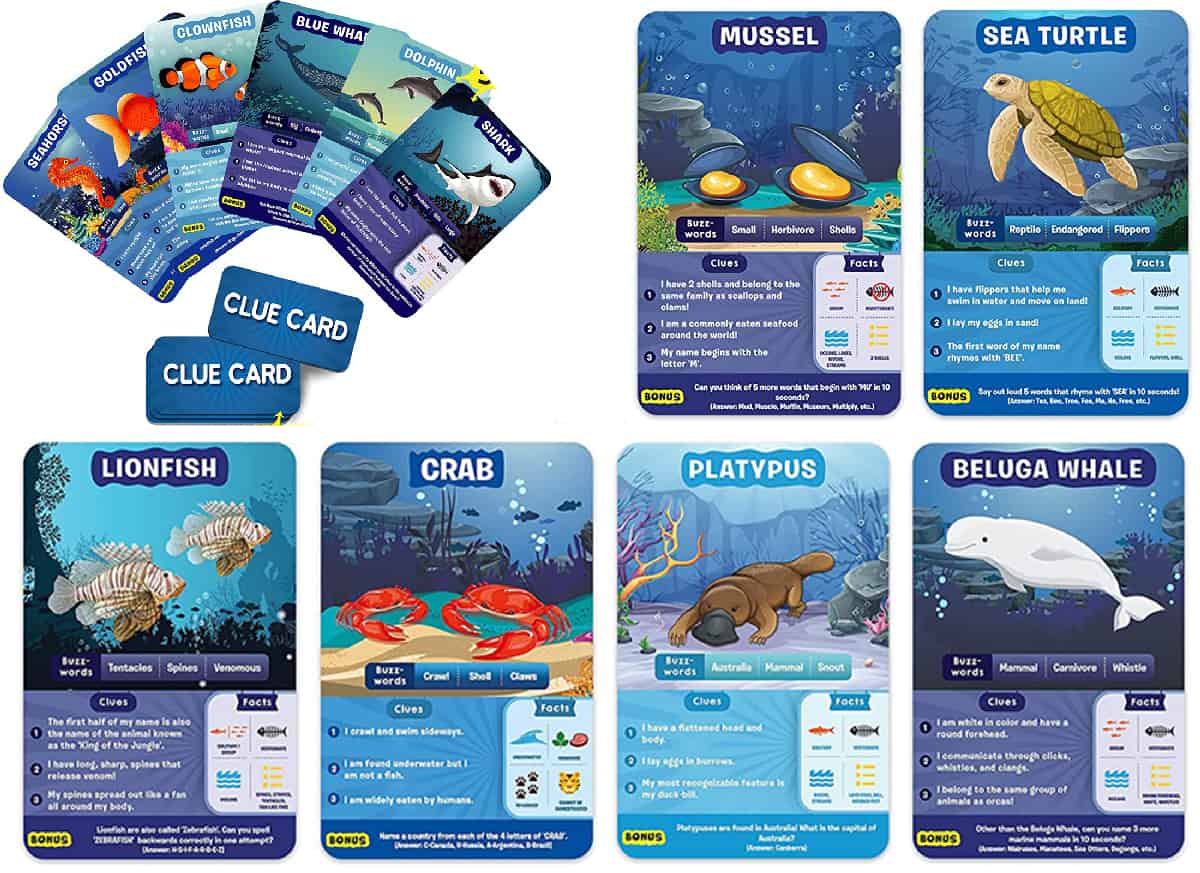
★★★☆☆
For Families and Schools | Age 8+ | 2-6 players | Price $20-$30 | Duration 10-20 min
Guess in 10: Underwater Animals is another quiz card game from Skillmatics about marine animals. This set comes with 50 game cards and 6 clue cards.
is another quiz card game from Skillmatics about marine animals. This set comes with 50 game cards and 6 clue cards.
This game is easy to play, as described in the previous card game in this post. And I like this game because:
- there is bite-sized information presented in the cards for easy recall
- some facts have tiny illustrations, which also makes it easier for younger children to recall new knowledge
- buzz words expand your child’s vocabulary
- this game develops communication skills
However, this game has only 50 cards, so it has low replayability.
What Bird Am I? (Outset Media)
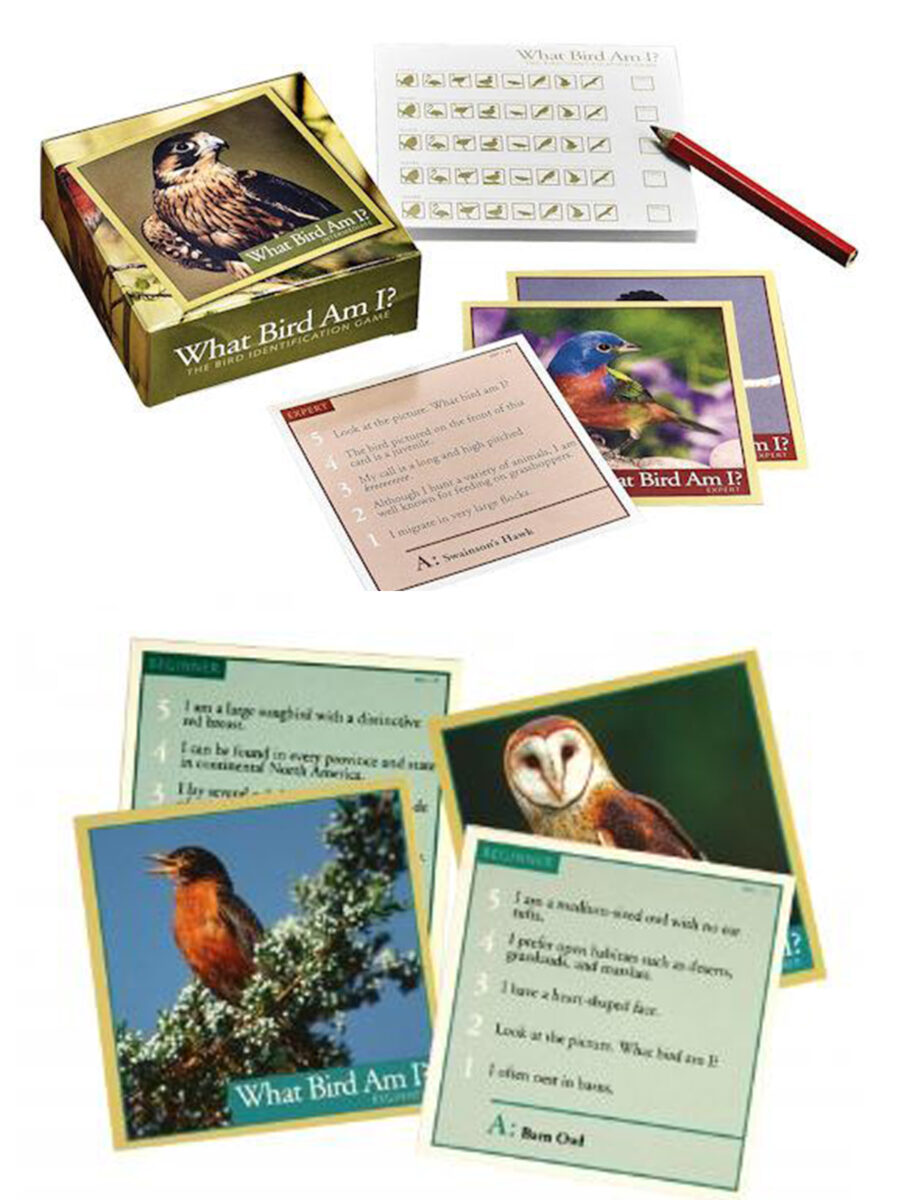
★★★☆☆
For Families and Schools | Age 14+ | 2+ players | Price $30-$40 | Duration 30-40 min
What Bird Am I ? is a trivia card game to challenge your knowledge about different bird species. It features 300 pictures of beautiful birds and five identifying clues to help you win a card.
? is a trivia card game to challenge your knowledge about different bird species. It features 300 pictures of beautiful birds and five identifying clues to help you win a card.
This game is easy to play. You only need to guess the name of the bird using the clues given. The fewer clues you use, the more points you get. By the end of your game, the player with the highest score wins the game. I like this game because:
- It has 300 cards, so it can be used in schools
- It features beautiful colored pictures of birds
- It can also be used to play I Spy with your children during your walks or long car rides
- It has three difficulty levels for the beginner, intermediate, and expert bird watcher
The game is recommended for aged 14 and up, but it can be played by younger children with extensive knowledge of bird species.
This game is filled with different trivia about birds. But some clues are not really helpful in guessing the birds. It also does not make sense why looking at the picture is often the fourth clue, which only gives you 2 points. The image is the first thing your opponent will see when they look at the card.
World of Animals (Top Trumps)

★★★★★
For Families and Schools | Age 8+ | 2+ players | Price $10-$30 | Duration 10-30 min
World of Animals by Top Trumps is a quiz card game that tests your knowledge about animals and how well you pay attention. It features 100 cards with 500 questions, which include true or false, multiple-choice, and identification types.
by Top Trumps is a quiz card game that tests your knowledge about animals and how well you pay attention. It features 100 cards with 500 questions, which include true or false, multiple-choice, and identification types.
The game has two rounds and can be played with two players or two teams. In the first round:
- Players or teams get five cards each.
- Then, they take turns quizzing each other with the questions on their cards.
- If they get the answers right, they keep the card. And the first player or team to win three pairs will win the round.
Once a team or player wins the first round, move on to the second. The twist is that the same cards are used in this round, and it tests how well players pay attention to each question and answer. Again, follow the same rules as above, and the first team or player to get three pairs wins.
The rules are easy to understand. The plastic case is sturdy. The questions are simple enough to be read by younger players. However, some of them may be difficult to answer, even for older children. The answers are on the back of the cards and may need to be covered during gameplay to prevent the other team from checking it out. And the game is very comprehensive with its 100 cards!
Bugs (Top Trumps)
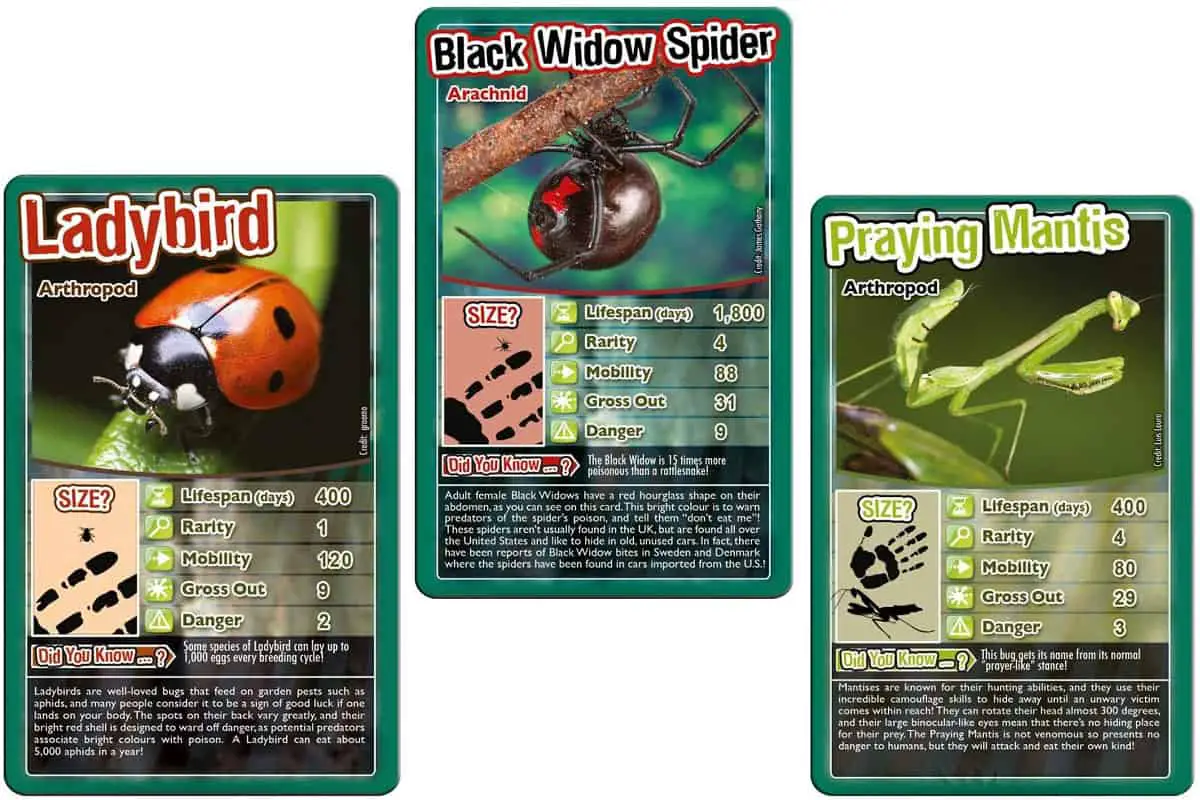
★★★☆☆
For Families | Age 7+ | 2-6 players | Price $10-$20 | Duration 20-30 min
Bugs is another game to add to your collection if you like the Top Trumps card games. This set features 30 trivia cards about these crawling creatures, which include the followings stats:
is another game to add to your collection if you like the Top Trumps card games. This set features 30 trivia cards about these crawling creatures, which include the followings stats:
- Lifespan in days
- Rarity
- Mobility
- Gross factor
- Danger level
There is not much reading required in this game, so even younger players can enjoy it. To play, evenly distribute the cards in face-down position among the players. Then, the first player calls out a stat from the topmost card on their hand. After that, whoever has the highest number in that category gets all the cards and decides what stat to play next. Then, the player who gets all the cards wins the game.
I like that:
- The rules are easy to follow.
- It teaches children bite-size facts that are engaging and easy to remember.
- Each card also features additional brief information about each bug.
However, there are only 30 cards.
Wildlife of North America (Outset Media – Professor Noggin’s)
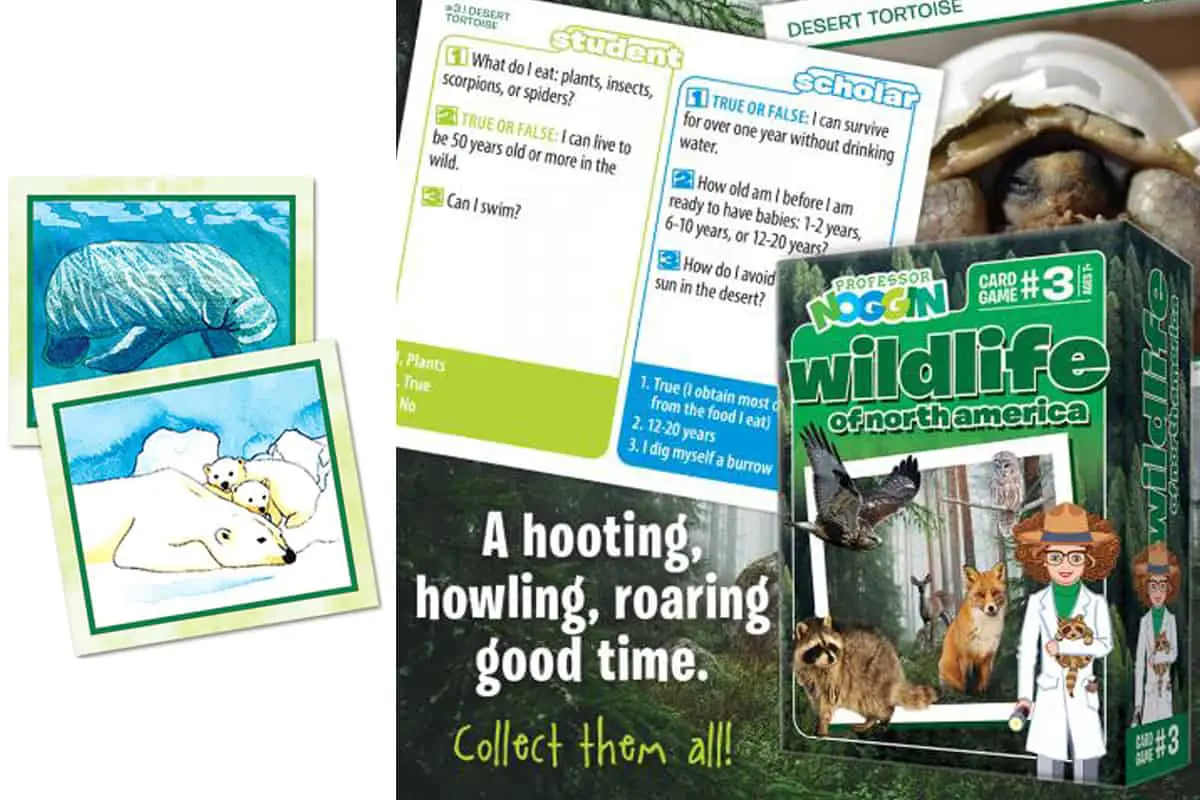
★★★★☆
For Families | Age 8+ | 2-8 players | Price $10-$20 | Duration 20-30 min
Wildlife of North America is about the different plants and animals found in North America. Like all Professor Noggins’s quiz games, this set features 30 trivia cards with two difficulty levels – easy and hard. There are also three types of questions for each level:
is about the different plants and animals found in North America. Like all Professor Noggins’s quiz games, this set features 30 trivia cards with two difficulty levels – easy and hard. There are also three types of questions for each level:
- True or false
- Trivia
- Multiple-choice
The game is easy to play. The instructions are as follows:
- Each player takes turns getting a card from the deck and rolling a die to determine which question to ask.
- Then, they quiz the person to their right. If they get it correctly, they keep the card. Otherwise, read the answer and return the card to the bottom of the deck.
- When the deck runs out, the player with the most cards wins the game.
I like this game because it tests the player’s attention as some cards may be played twice (if they are answered incorrectly on the first try.) It also offers two levels of gameplay, which makes the game challenging to older players. It also features easy-to-read questions for younger players. And since each card has six questions, each set comes with 180 in total, which keeps the game exciting and entertaining even after several gameplays.
Reptiles and Amphibians (Outset Media – Professor Noggin’s)

★★★★☆
For Families | Age 8+ | 2-8 players | Price $10-$20 | Duration 20-30 min
Professor Noggin’s Reptiles and Amphibians is a quiz card game about these cold-blooded animals. It comes with 30 question cards with different questions – true or false, multiple-choice, and questions with specific answers.
is a quiz card game about these cold-blooded animals. It comes with 30 question cards with different questions – true or false, multiple-choice, and questions with specific answers.
Each card also focuses on a specific topic:
- Alligators
- Amphibians
- Boa Constrictors
- Chameleons
- Crocodiles
- Dangerous Snakes
- Eggs
- Endangered Species
- Frogs
- Geckos
- Iguanas
- Komodo Dragons
- Lizards
- Poisonous Frogs
- Poisonous Reptiles
- Rattlesnakes
- Reptiles
- Reptiles Versus Amphibians
- Salamanders
- Sand Vipers
- Sea Turtles
- Sirens
- Snakes
- Snapping Turtles
- Tadpoles
- Toads
- Tree Frogs
- Tuatara
- Turtles
- Unusual Reptiles
I like that it covers many categories. There are six questions on each card, so that you a lot about reptiles and amphibians. Adults can also play with younger players and take the “scholar”-level questions instead of the “student”-level ones.
World of Dinosaurs (Outset Media – Professor Noggin’s)
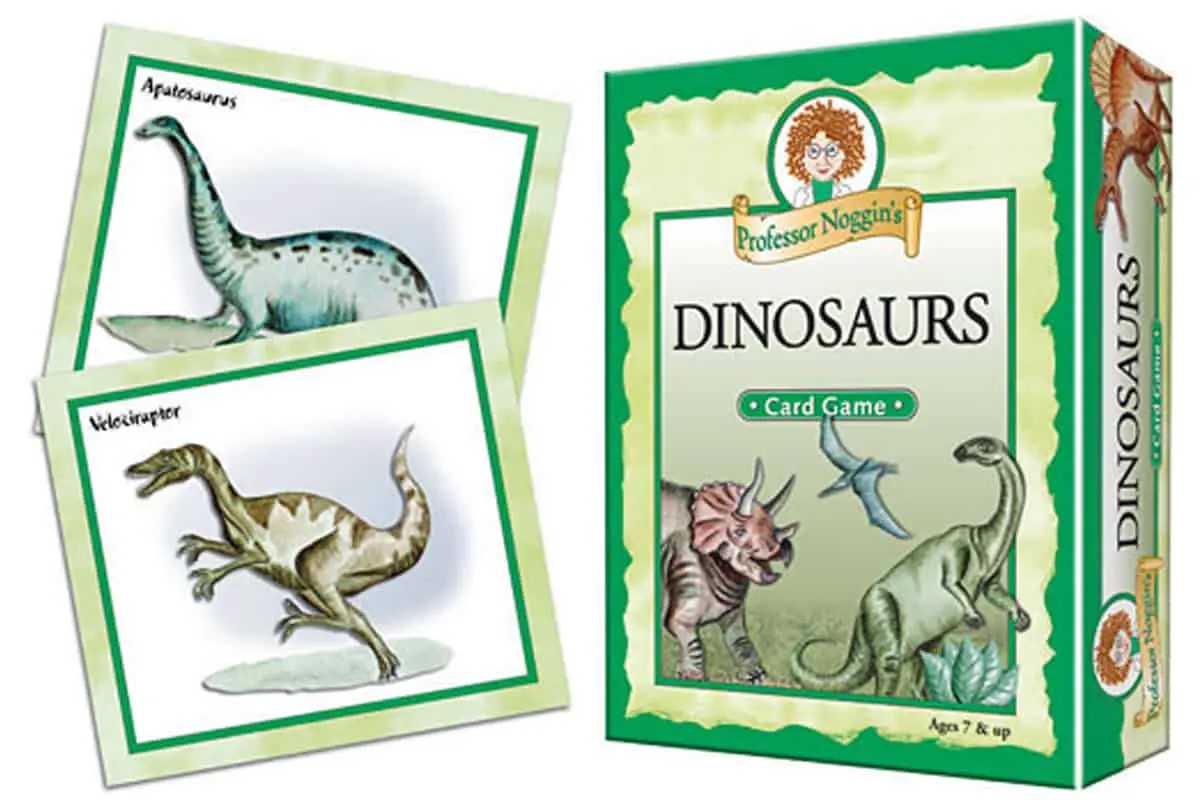
★★★★☆
For Families | Age 8+ | 2-8 players | Price $10-$20 | Duration 20-30 min
If your child loves dinosaurs, then Professor Noggin’s World of Dinosaurs will definitely entertain them. This set comes with 30 trivia cards about the different dinosaurs and plants that lived on the planet when dinosaurs were alive.
will definitely entertain them. This set comes with 30 trivia cards about the different dinosaurs and plants that lived on the planet when dinosaurs were alive.
There is a specific topic in each card:
- Allosaurus
- Ankylosaurus
- Apatosaurus
- Archaeopteryx
- Brachiosaurus
- Corythosaurus
- Dinosaur Bones
- Dinosaur Museum
- Extinction
- Fossil Excavation
- Fossils
- General Topic Card
- Ichthyosaurus
- Iguanadon
- Ouranosaurus
- Ornithomimus
- Pachycephalosaurus
- Parasaurolophus
- Plants of the Mesozoic Era
- Plateosaurus
- Protoceratops
- Pteranodon
- Reproduction
- Rhamphorhynchus
- Spinosaurus
- Stegosaurus
- Triceratops
- Tyrannosaurus
- Utahraptor
- Velociraptor
This quiz card game has 180 questions in total, so your child will learn many educational and fun facts about dinosaurs and fauna in their era.
Birds of North America (Outset Media – Professor Noggin’s)

★★★☆☆
For Families | Age 8+ | 2-8 players | Price $10-$20 | Duration 20-30 min
Birds of North America is another Professor Noggin’s quiz card game that focuses on the different avian species in this continent. It includes 30 question cards featuring fascinating bird facts like their habitats and unique behaviors.
is another Professor Noggin’s quiz card game that focuses on the different avian species in this continent. It includes 30 question cards featuring fascinating bird facts like their habitats and unique behaviors.
Each card focuses on a specific topic:
- American Kestrel
- American Swallow-tailed Kite
- Anhinga
- Barn Owl
- Barn Swallow
- Blackbird
- Blue Jay
- Canada Goose
- Common Raven
- General Topic Card
- Great Blue Heron
- Great-horned Owl
- Gull
- Hummingbird
- Kingfisher
- Loon
- Northern Cardinal
- Northern Pintail
- Orioles
- Pelican
- Puffin
- Ring-necked Pheasant
- Ruddy Duck
- Scarlet Tanager
- Sparrow
- Turkey Vulture
- White-breasted Nuthatch
- Woodpecker (Card A)
- Woodpecker (Card B)
- Yellow Warbler
I like this game because:
- it features different types of trivia about birds.
- It is also easy to play because the rules are simple.
- The cards show actual pictures of the birds.
However, younger players may still find the “easy” questions hard to answer if they are not interested or familiar with the different avian species.
Insects and Spiders (Outset Media – Professor Noggin’s)

★★★☆☆
For Families | Age 8+ | 2-8 players | Price $10-$20 | Duration 20-30 min
Insects and Spiders is another Professor Noggin’s quiz card game that focuses on different types of insects and spiders. Each question card has two difficulty levels and six questions that combine true or false, multiple-choice, and specific answer questions.
is another Professor Noggin’s quiz card game that focuses on different types of insects and spiders. Each question card has two difficulty levels and six questions that combine true or false, multiple-choice, and specific answer questions.
Like the other games in Professor Noggin’s series, each question card has a specific topic. Included in this set are:
- Ants
- Black Widow Spiders
- Dangerous Insects
- Dragonflies
- Earthworms
- Earwigs
- Fireflies
- Fleas
- Flies
- General Topic Card (2)
- Honeybees
- Insect Anatomy
- Jumping Spiders
- Ladybugs
- Monarchs
- Mosquitoes
- Moths
- Northern Walking sticks
- Pests and Plagues
- Praying Mantises
- Spiders
- Stink Bugs
- Treehoppers
- Water Striders
- Weird Insects
- Whirligigs
- Wolf Spiders
- Wood Lice
- Woolly Bear Caterpillars
I like that there are 180 questions in this set which is great for replayability. However, the hard questions may be too difficult even for older players. In addition, some of them look for specific types of insects or spiders that may not be familiar to players unless they have extensive knowledge of these creatures.
Life in the Ocean (Outset Media – Professor Noggin’s)
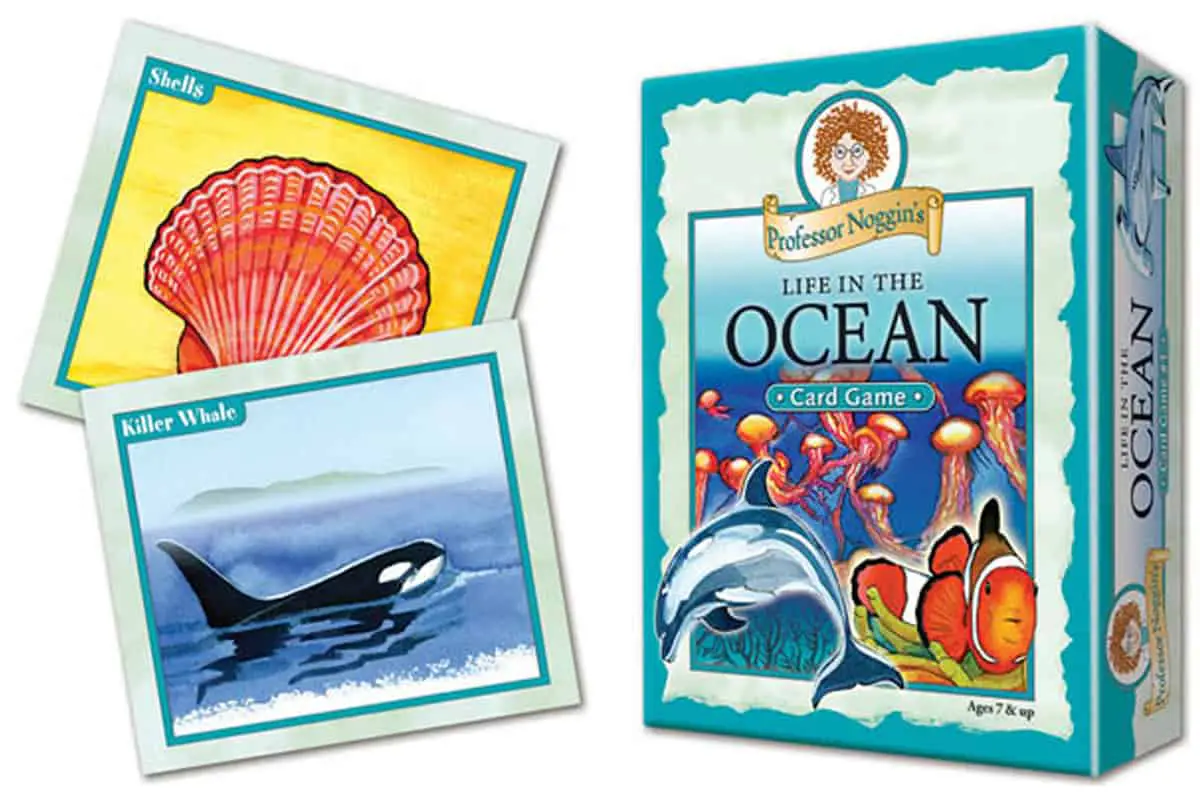
★★★★☆
For Families | Age 8+ | 2-8 players | Price $10-$20 | Duration 20-30 min
Professor Noggin’s Life in the Ocean is a quiz card game featuring different ocean animals. Each set comes with 30 question cards with six questions each to entertain and educate your children.
is a quiz card game featuring different ocean animals. Each set comes with 30 question cards with six questions each to entertain and educate your children.
Like in previous installations to Professor Noggin’s quiz card games, each card has a specific topic. Life in the Ocean includes:
- Albatross
- Beluga Whale
- Blue Whale
- Bottlenose Dolphin
- California Sea Lion
- California Sea Otter
- Clownfish
- Conch
- Coral
- General Topic Card
- Great White Shark
- Hammerhead Shark
- Hermit Crab
- Jellyfish
- Kelp
- Killer Whale
- Lobster
- Loggerhead Sea Turtle
- Marlin
- Narwhal
- Octopus
- Penguin
- Pollution
- Seahorse
- Sea Urchin
- Shells
- Starfish
- Stingray
- Tuna
- Walrus
There are 180 questions in this set, so it can be played several times with your children. Older versions have illustrated animals, and the newer ones have actual pictures of ocean creatures.
Wildlife Safari (Outset Media – Professor Noggin’s)
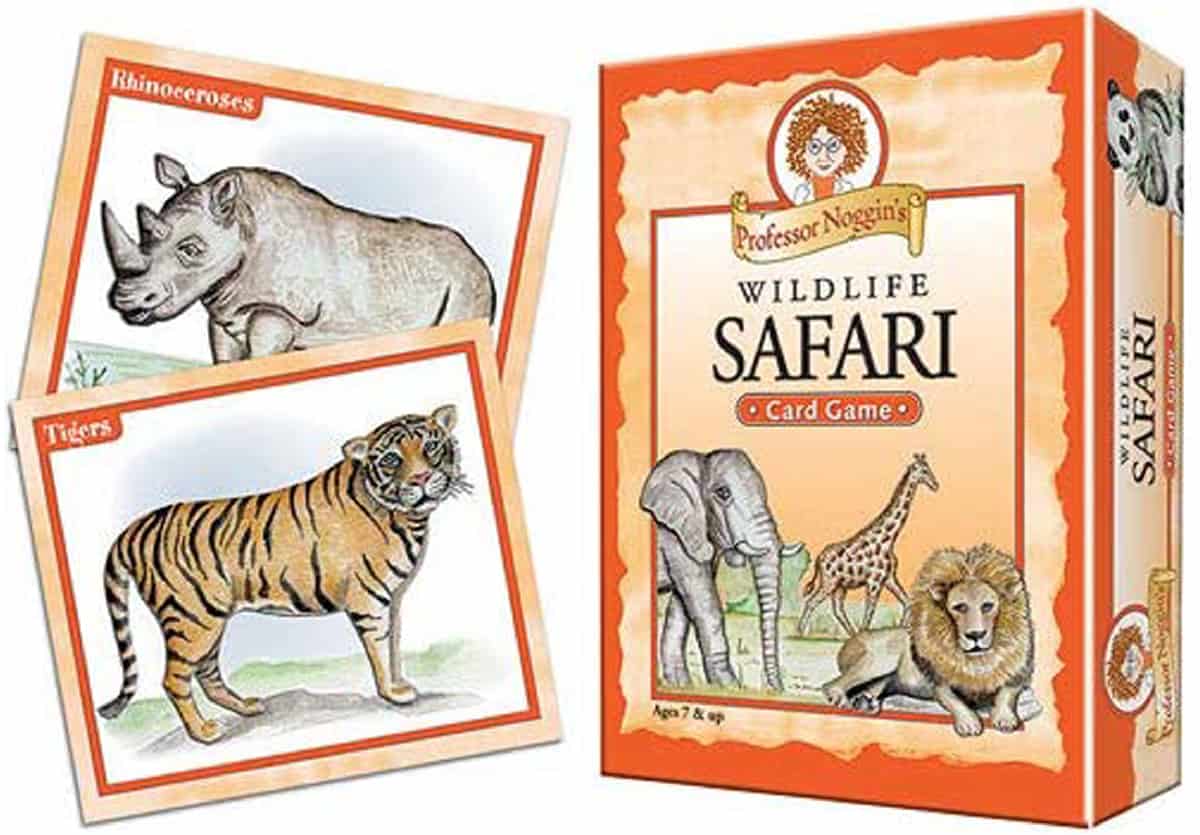
★★★★☆
For Families | Age 8+ | 2-8 players | Price $10-$20 | Duration 20-30 min
Wildlife Safari is a quiz card game about different animals that you can spot on a safari. It has 30 question cards with two levels of difficulty – easy and hard.
is a quiz card game about different animals that you can spot on a safari. It has 30 question cards with two levels of difficulty – easy and hard.
This set covers different mammals and birds that live in a wildlife safari. Each card covers a specific topic which includes:
- African Elephants
- Anteaters
- Armadillos
- Camels
- Cheetahs
- Gemsboks
- Gibbons
- Giraffes
- Gorillas
- Hippopotamuses
- Hyenas
- Kangaroos
- Koalas
- Lemurs
- Lions
- Mandrills
- Orangutans
- Ostriches
- Pandas
- Peacocks
- Platypuses
- Rhinoceroses
- Scarlet Macaws
- Sloths
- Tapirs
- Tasmanian Devils
- Tigers
- Toucans
- Wildebeests
- Zebras
I like that there are mammals and birds in this set, instead of only one animal group. However, I think it will be better if more types are included in this set because many other animals are living in a wildlife safari.
General Biology Card Games
Wacky Cards: Life Science Edition (Think2Master)

★★★☆☆
For Schools | Age 8+ | 2-8 players | Price $30-$40 | Duration 20-30 min
Wacky Cards: Life Science Edition is a quiz card game that covers several biology topics. Each box has 91 question cards, over 180 questions, 99 adjective cards, 99 noun cards, and 8 player cards.
is a quiz card game that covers several biology topics. Each box has 91 question cards, over 180 questions, 99 adjective cards, 99 noun cards, and 8 player cards.
This set will help your students learn about:
- DNA
- Photosynthesis
- Genetics
- Plants
- Animals
- Viruses
- Bacteria
- Evolution
- Cells and organelles
The game is easy to play. For each round:
- Players need to pick a judge to read a question card.
- Then, the other players write their answers on their writable cards.
- The judge checks the answers, tallies the score, and then shows the sentence at the back of the question card.
- The players pick the best noun and adjective card to complete the sentence. Then, the judge determines the best answer and adds the score to the card.
I like this game because it covers several topics in biology. It also lets children practice their language skills while learning about science. There are also two levels of questions – easy and hard, so both younger and older players can enjoy the game. Lastly, all cards are writable.
The problem with this game is that some of the “easy” questions may be too hard for younger players, while others are too easy. So, the adult may need to gauge each question’s true level of difficulty, depending on the children.
Nerd Words: Science! (Genius Games)
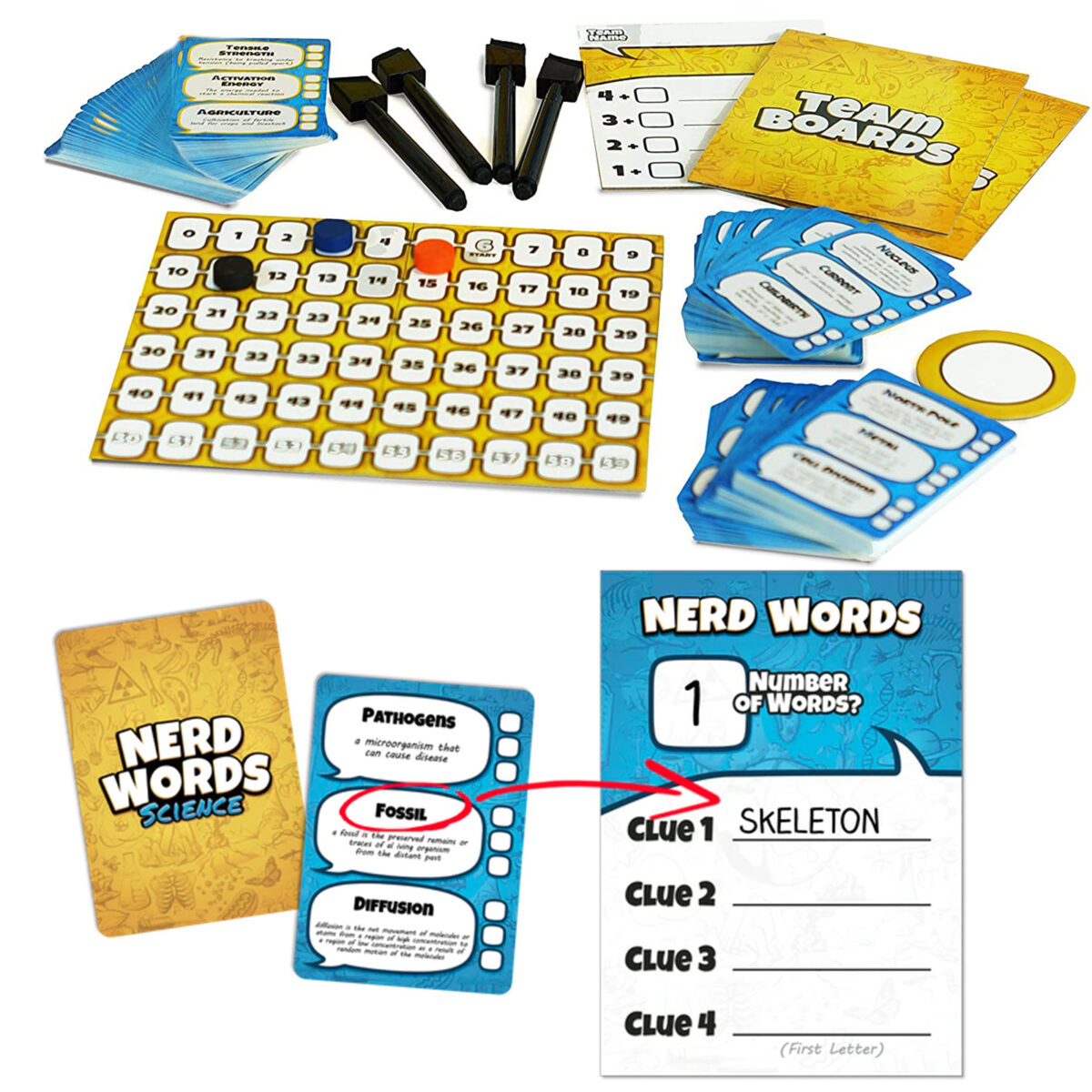
★★★★☆
For Families and Schools | Age 14+ | 2-12 players | Price $10-$30 | Duration 20-30 min
Nerd Words: Science! is a fast-paced science word game designed to expand your knowledge and vocabulary of different scientific terms. It covers several topics, including biology, chemistry, physics, and earth science, to suit high school students.
is a fast-paced science word game designed to expand your knowledge and vocabulary of different scientific terms. It covers several topics, including biology, chemistry, physics, and earth science, to suit high school students.
Each set comes with over 200 nerd words. To play:
- Form 2-3 teams and pick your team token and whiteboard. Then, select the clue giver.
- The clue giver picks a nerd word and gives a one-word clue that starts with any letter from the scientific term. For clues 1-3, the clue-giver cannot use the first letter of the word. (The clue giver may also place a bet while giving the first three clues and the winning teams get these points.)
- After each clue, the teams have to place bets and give their answers within a 60-second time limit.
- If the teams haven’t guessed the word after three clues, the fourth clue is given. And it needs to start with the first letter of the science term.
- The game ends when a team gets 50 points, or every player has become a clue-giver twice.
The game is challenging for both the clue giver and the guessing teams because they need a creative and vast vocabulary.
I like this game because:
- it expands the players’ vocabulary and develops their deductive skills
- It also forces them to think outside the box, especially when giving one-word clues for each scientific term
- it also has 162 nerd cards with 3 science terms each, so this game has great replayability
While thinking about clue words is challenging, it can also be a downside to the game. Some players may lose interest in playing, especially when it becomes too difficult to give a clue word. I also can’t give this game five stars because initially, it is challenging to play since there are several specific rules to follow.
Other Science Games to Play at Homes or Schools
Biology is such a vast and complicated subject. Using games to complement some lessons can make learning about this life science easier and enjoyable for students. If you want to know more science games to include in your classes or homes, check out these other posts:
- 11 Biology Board Games for Home and School

- 6 Physics Board Games for Families and Schools

- 13 Top Chemistry Board Games for Schools and Families

Edudingo.com is a participant in the Amazon Services LLC Associates Program, an affiliate advertising program designed to provide a means for sites to earn advertising fees by advertising and linking to Amazon.com. We also participate in other affiliate programs which compensate us for referring traffic.

